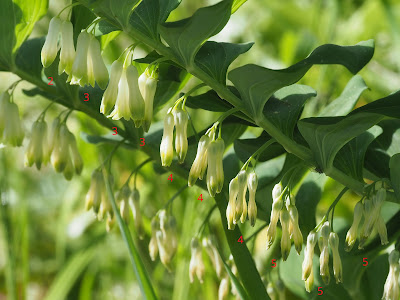Common name: Scot Pine
Scientific name: Pinus sylvestris 歐洲赤松
Genus: Pinus 松屬
Family: Pinaceae 松科, pine family
Class: Pinopsida 松柏網
Divison: Pinophyta 松柏門
Origin: native
Date: 11th and 8th May (male and female cones)
An evergreen tree, can grow up to 40 m. The following 4 photos [404-407]
showing the tree trunks from the base to the top:
[407]
[404] Tree barks on the stem.
[410] Look at the upper trunk. This photo is taken at the lateral branch.
[410_1] The distinctive orange-brown (B) trunk, shed in peeling scales.
[411] Another lateral branch.
[411_1] The distinctive orange-brown (B) trunk, shed in peeling scales.
[183_1] Needles at the base of the male cones.
[401_1] Needles in pairs.
[184_1] Needles 4-8 cm, twisted and rather blue-green (glaucous 淡灰綠色,表面有一層白霜的).
----------------------------------------------------------
[190] A lot of male cones. (taken on 11th May)
[400] A lot of male cones at the base of new shoot.
[400_1] Enlarged photo above showing one male cone (strobilus) with microsporophylls.
----------------------------------------------------------
[408] Some female cones are found at the tips of new shoots. Note that Pinus sylvestri is monoecious, so both male and female cones could be seen on the same tree.
[408_1a] Female cones (red structures above) are found at the tips of new shoots.
[408_1b] Female cones (red structures above) are found at the tips of new shoots. An green immature cone could also be seen above.
[408_2a] Another position of the tree: female cones (red structures above) are found at the tips of new shoots.
The following 3 photos [414, 415, 415_1] were taken from another young plant showing the new shoot.
[414] New shoots developing.
[415] New shoots.
[415_1] Enlarged above to show the tip of new shoot, new needles are emerging from brown leaf sheaths. Female cones may appears at the tip of the new shoot afterwards.
[408_2b] Another position of the tree: female cones (red structures above) are found at the tips of new shoots.
[408_3a] Female cones (red structures above) are found at the tips of new shoots. An green immature cone could also be seen above.
[408_4] Yellow male cones and green immature cones could be seen above.
[408_3b] An green immature cone.
[398] A mature (female) cone 3-7 cm, with woody seed scales already opened to release the seeds. The cone scales (seed scales) are not spine-tipped.













































































